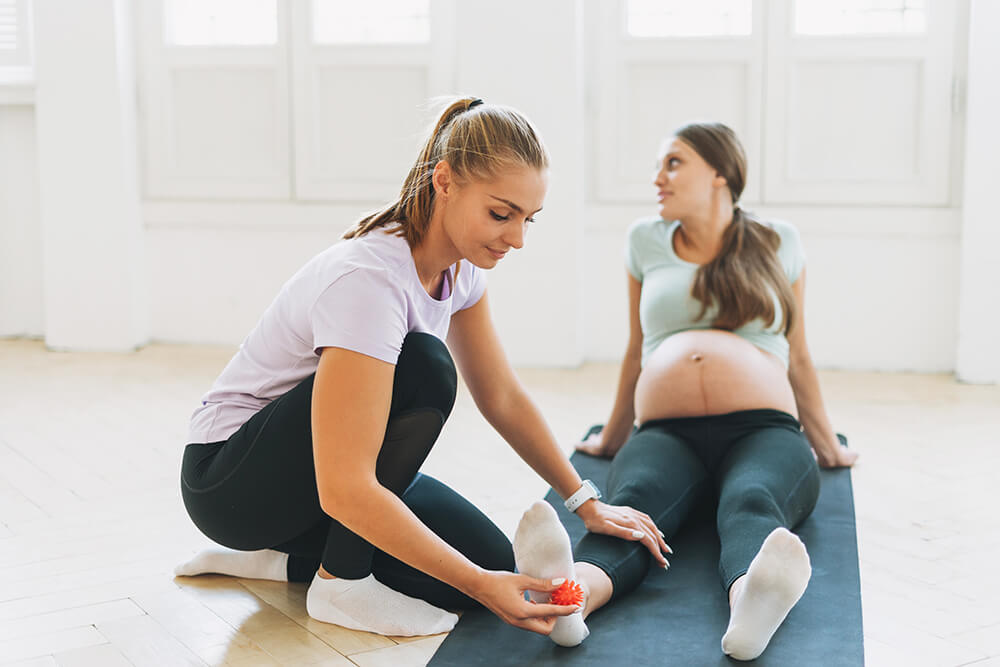Pregnancy and childbirth can take a toll on your body. After completing a pregnancy, you may feel several lasting side effects. One of the most common is postpartum foot pain. With all the other responsibilities and life changes that come with pregnancy, it can be difficult to find time for addressing health concerns like this. Fortunately, this foot pain can be treated with some quick and easy practices. Getting relief can let you focus on the things that are most important.
What causes postpartum foot pain?
Postpartum foot pain can begin during pregnancy and continue for some time after. Symptoms often begin during the second and third trimesters. A history of previous pain can be a risk factor for developing foot pain during or after a pregnancy. The significant physical changes that come with pregnancy can also play a role. Increased weight, hormonal changes and inflammation can all be factors in postpartum foot pain.
Tips for managing postpartum foot pain
Everyone is different; some solutions may be more effective for one individual than another. The variety of tips listed here take that into account. These expert suggestions are designed to alleviate postpartum foot pain by using techniques that most individuals can apply.
- Wear supportive footwear — Supportive footwear is crucial for people experiencing foot pain. Wearing compression socks and comfortable shoes can help ease your foot pain. Look for shoes with good arch support, a well-fitting toe box and cushioned soles. It may help to avoid high heels or any other shoes that put extra stress on your toes. Opt for shoes that are breathable, like running shoes and sneakers. Wearing padded slippers at home can help as well.
- Use orthotics — To boost the benefits of supportive footwear, you may want to consider orthotic inserts for your shoes. These are molded slip-in insoles that can be used with most shoes. Orthotics can be custom-made for your feet to target the areas where you need support. They are designed to improve foot alignment and reduce pressure, which can reduce pain and discomfort.
- Do foot stretches — Stretching can help alleviate foot pain. Exercises that relax the muscles and tendons in your legs can have benefits that spread down to your feet. All the parts of your legs are connected, so flexibility in one part can help reduce stress on others. Stretches that target your calves and knees especially can help reduce foot pain.
- Try hot and cold therapy — Hot and cold therapy is a physical therapy technique you can practice from the comfort of your own home. Your physical therapy specialist may recommend this as a technique to use between visits to help relieve pain. This technique works by using temperature changes to adjust your body. Hot therapy can improve circulation and reduce stiffness. Cold therapy can be used on swollen areas to reduce inflammation. Your physical therapist can help determine the best way to use this treatment for managing your postpartum foot pain.
- Massage your feet — Massage can be an effective way to alleviate foot pain. Massaging the soles of your feet with a foam roller can offer immediate feelings of relief. For best results, focus on areas where you experience tightness and discomfort. Physical therapists also offer expert targeted massage through manual therapy techniques.
- Maintain a healthy weight — Postpartum pain can be made worse by additional weight gain. To minimize the impact weight has on your symptoms, you can work to maintain a healthy weight. This can be done through exercise routines and smart diet choices. A healthy weight can help with foot pain and improve your overall health.
- Elevate your feet — Elevating your feet can improve circulation, leading to less inflammation. This can improve recovery from your foot pain symptoms. To keep your feet elevated whenever possible, you can try using pillows or a footrest to prop your feet up when you’re sitting. Reclining chairs can also be helpful. It can also help to elevate your feet overnight while you sleep.
- Consult with a physical therapist — At-home solutions can be effective, but they can only get you so far. For specialized treatment that can effectively manage your postpartum foot pain, physical therapy is an excellent option. After a free screening, physical therapy specialists can work with you to build a treatment plan that works for your specific needs.
Peak Performance Sports and Physical Therapy can help manage your postpartum foot pain
Let us help you get the pain management solutions you need at Peak Performance. In addition to techniques like manual therapy, we offer a range of treatments including aquatic therapy. Postpartum foot pain is a common issue, but it doesn’t need to be a permanent one. By following our expert suggestions and consulting with a physical therapy specialist, you can be on the road to recovery as soon as possible.
Contact us today for more information about postpartum foot pain management or to schedule an initial appointment.

